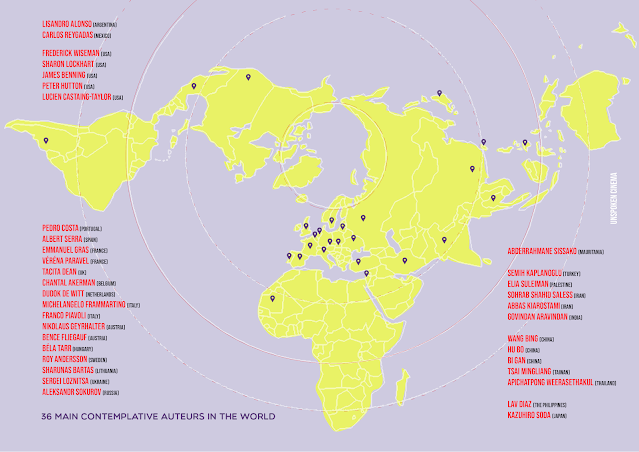Contemplative World Map
(Designed by Benoit Rouilly)
The 36 most important Contemplative Cinema auteurs are pinned to this polar-projection map of the world. This restricted sample of filmmakers cover the whole map. I suspect if we compared to a map of most active art-cinema nations in the world it would pretty much overlap exactly. A sample of "Slow Cinema", which is broader and more inclusive, would comfirm the overlap more obviously...
Some critics attempted to demonstrate that "Slow Cinema" originated in Asia mainly by citing only TSAI, WEERASETHAKUL, WANG Bing, HOU HsiaoHsien, Edward YANG, DIAZ, KIAROSTAMI, ARAVINDAN, JIA Zhangke, LEE Changdong... Firstly, some of them are either precursor to the Contemplative narrative aesthetics (less minimalist), some are on the side line (less austere). Secondly, it would overlook a sizeable half of this aesthetics representatives, mainly issued from Europe and the USA. It would be unfair to ignore AKERMAN, TARR, FRAMMARTINO, GEYRHALTER, BARTAS, LOZNITSA, SOKUROV, ALONSO, REYGADAS, WISEMAN, BENNING... who deserve mention in the same breath as the former list.
The fact is that Europe is a cradle for artfilm auteurs in the margin of the mainstream, because of the local festival circuit, the cinema schools and the public theatres network, all contributes to develop a cinephilic culture in the population at large and a favorable nest for the new generation of future filmmakers.
This makes it all the more extraordinary for artfilm auteurs to emerge outside of these fertile conditions (Europe, or USA to some extant), in the South (like South America, Africa, and Asia), so we should apraise all the way, even though the European festivals and funds largely support their birth and growth, financially and culturally. Paul Schrader claims the reason for this enthousiasm in these regions is precisely because Contemplative Cinema is cheap to make, but I find it quite unfair to overlook the courage and boldness to come up with a debut feature, foreign to the local taste, that will only play on the festival circuit and not at home, on the mainstream circuit.
Another salient point rising from this map is that Contemplative Cinema is transnational, it is not limited to one region, nor is it dominated by one country (except maybe the USA with 5 names out of 36). Contemplative films emerge from all sorts of backgrounds, cultural and political. It is not limited in scope to this map, because aside from the main auteurs (with consistent Contemplative production), there are many one-off or occasional films in the filmography of filmmakers not truly contemplative otherwise (see the up-to-date list of Recommended CCC).

Comments